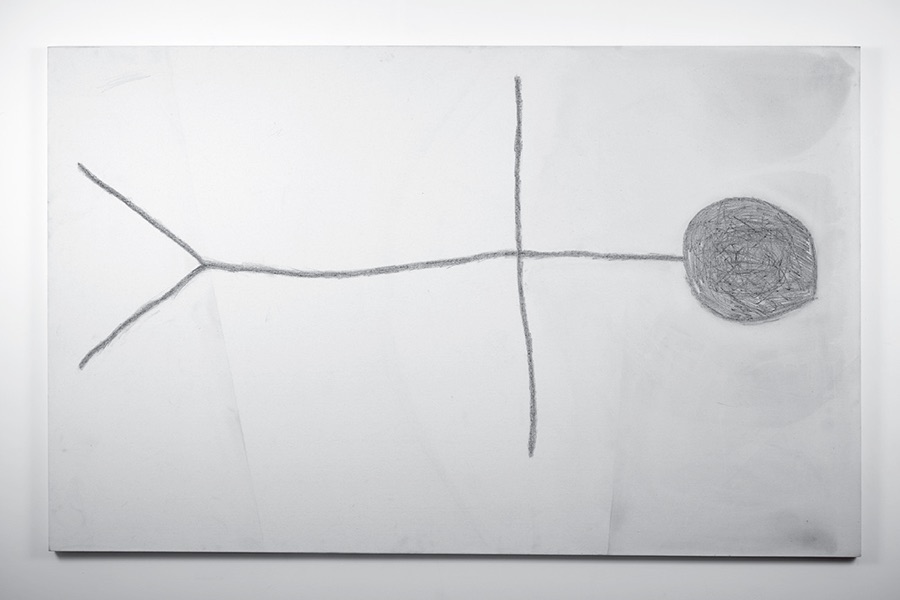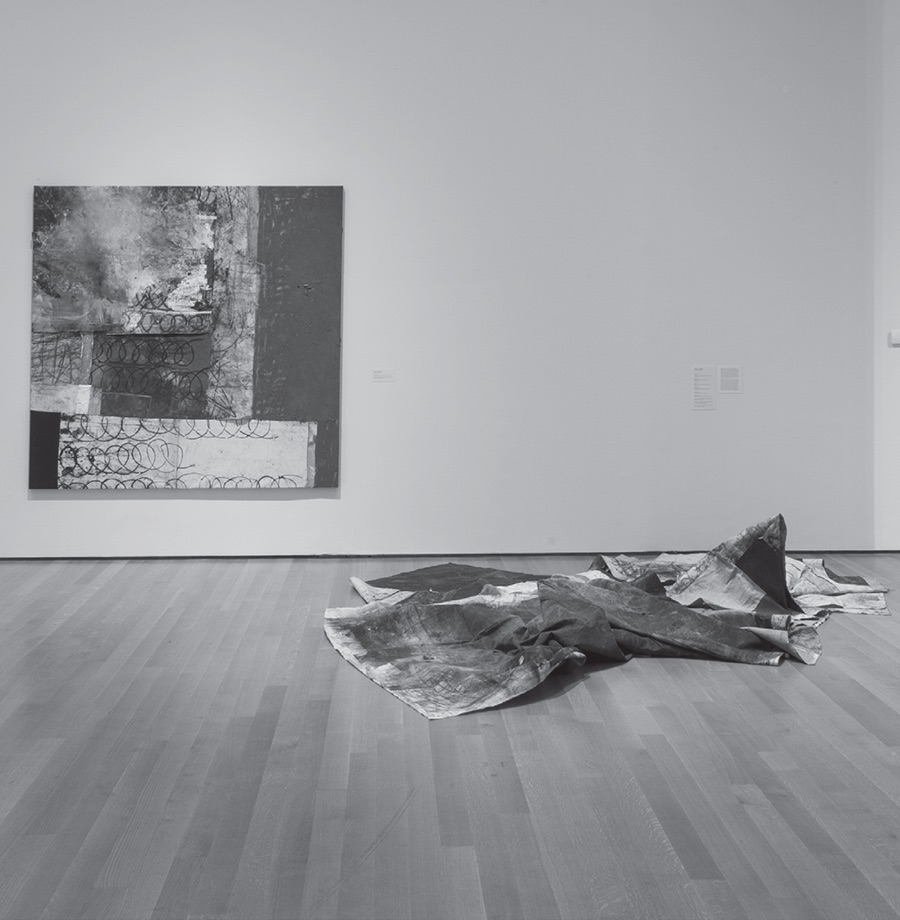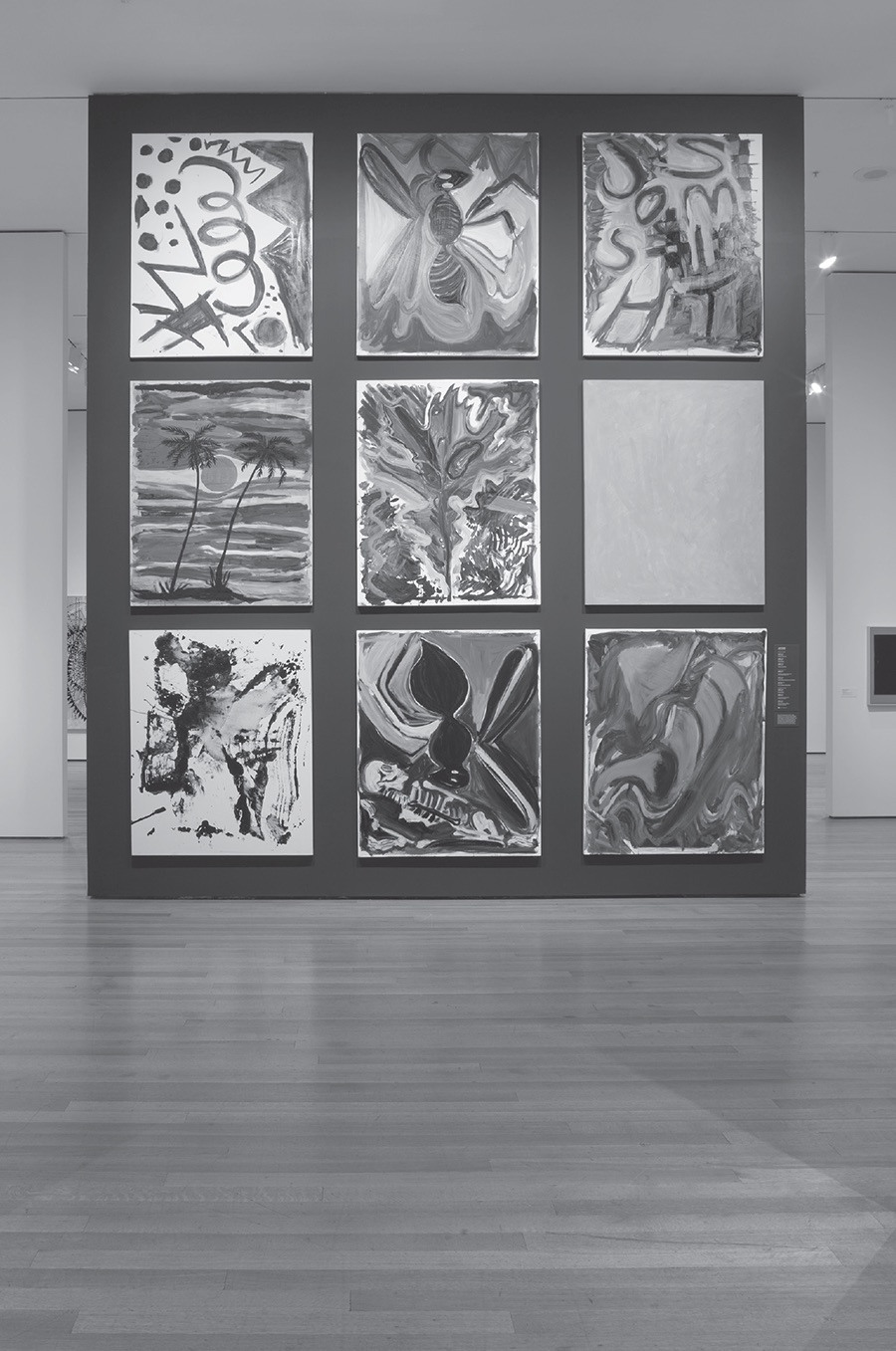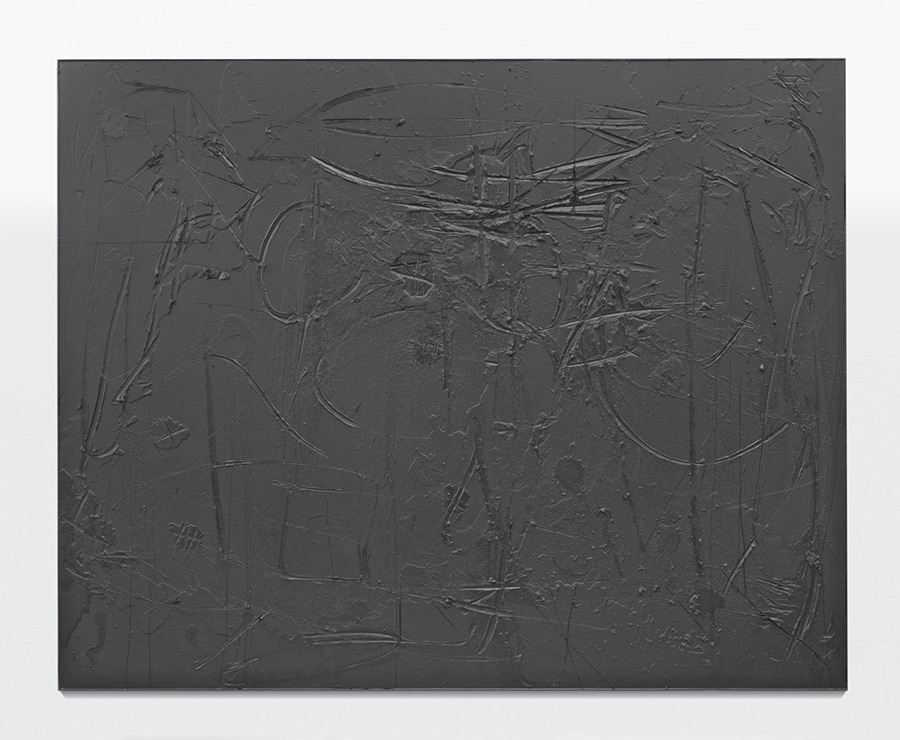SHALL WE BEGIN BY TOURING an art exhibit? From December 2014 to April 2015, the Museum of Modern Art ran The Forever Now, a survey of paintings from seventeen midcareer artists. Echoing MoMA’s 1958 The New American Painting, which also featured seventeen artists and was the last time the museum devoted an exhibit to new paintings, The Forever Now aimed to build a canon. But its artists responded to a different world, as the exhibit curator Laura Hoptman explained: one in which an entire catalog of paintings and styles throughout history is readily available on Wikipedia but in which painting itself has lost out in visual culture to the rise of digital screens, from Netflix to iPhones.1 What is a contemporary painter to do in a world with both too much information about painting and too little recognition of painting?
Just past the entrance to the exhibit, we first encounter a towering wall with six imposing canvases by Joe Bradley. On each canvas, Bradley has crudely rendered abstract symbols in grease pencil, an exercise in the meanings that can be produced through an elementary language of line and curve. The middle canvas is the only one with a filled form: a scribbled circle that appears as the head of a horizontal stick figure, although the title, Man Made Dirigible, suggests the morphing of human form into schematic flying machine (Figure 1.1). “The human body is the starship we’re all operating from,” Bradley has said, which makes both a kind of container from the elements, sealed off from atmosphere.2 There is something simultaneously modern and mythic about the painting, a return historically to primordial cave paintings and technically to the doodles of a child, both of which suggest a search for that containment, that womb before the world got complicated. It is a style of detoxing, not merely a regression to primitive forms, but a shutting out of outside noise; the gestures in pencil produce a sort of bubble in which the fantasy of being shielded from all that noise can—at least while focused on this simple pencil—be nourished. And the largeness of the works—for he is not doodling on printer paper but painting on large canvases—speaks to the desire both to simplify and to amplify, or to make the bubble bigger by focusing on its simple construction.

Further into the exhibit, Oscar Murillo’s work could not be more different. If Bradley detoxes the overabundance of noise, Murillo collects it. His wall space features stretched canvases in bright and clashing color that have collected all the stuff that a reduction to the elemental seeks to purify or expunge: dirt, detritus (Figure 1.2). He has described his studio as a “cradle of dust and dirt, of pollution” and invites his canvases to be “contaminated.” He calls his own process one of trying to “get through as much material as possible”: “I don’t work on a painting with the goal of finishing it or having a complete and finished painting at the end of a work process.”3 He seeks not to escape but to imitate how there is “so much movement in the world, constantly.”4 His style is one of bingeing, as if, in a world with too much where he cannot know what might matter, the best strategy is to collect all matter. His canvases are stitched together, sewn with needle and thread: they manifest a desire for everything to be connected, for an abandonment of hierarchy in which each thing might have a category and a place. Rather than containment, a bubble, there is the breach: a feeling out for more, an addict’s attempt to keep the trip going. And as with any addiction, there is a risk to this process of what Hal Foster might call “mimetic exacerbation,” the “risk of an excessive identification with the corrupt conditions of a symbolic order.”5 Fighting too-muchness with too-muchness, bingeing blurs the division between resisting and merging with the world.
On the obverse side of the wall that displays Bradley’s canvases, Josh Smith’s paintings present a gridded order as if to rebuke Murillo’s anarchism. Here are nine paintings of identical size, each five feet by four, neatly arrayed in a three-by-three matrix (Figure 1.3). Each has its own aesthetic—one a solid plane of palliated lime green, another a blue doodle, yet another a tropical postcard: a sun setting between two palm trees, thick horizontal layers of primary colors filling the sky. In the top right is one of the “name paintings” Smith became famous for at the turn of the millennium: his own, unremarkable name in capital letters spelled out in large green markings, with a glow of bright swatches around it. Smith has called himself an “exhibitionist,” but he is not a naked one: each canvas exhibits his name in a different way, a different mood, based on the color and the extent to which his gestures flail.6 A decade before filtering on photographic social media platforms like Snapchat allowed users to show up as a puppy one day and a zombie the next, Smith’s canvases allow his own name to show up in a specific range of affects, one at a time. Yet this search for multiplicity—trying on one filter today and another filter tomorrow—is not about integration or connection, as it was for Murillo’s bingeing into a continuous present; the three-by-three grid is about putting each scene in its proper place: a style not of the palimpsest but of the catalog. This is a style not only of iterative self-fashioning but of its standardization.


Were we to look for an antidote to this sequential exhibitionism, we would find it in Rashid Johnson’s singular contributions to the exhibit, drawn from a series he calls Cosmic Slop (Figure 1.4). Each begins as a large black rectangle of melted soap and wax that Johnson carves into before it resolidifies. It is a kind of negative abstract expressionism, not a flinging of paint onto a canvas—in fact there is no substance but the wax canvas itself—but still a gesturing that produces form through the elimination of canvas. Moreover, the temporal finitude of the process—the time limit imposed by the hardening of the medium—twins Johnson’s presentation and withdrawal of a self. He presents a personal gesture but is not there to see how it is taken up, how it is engaged. Johnson is ghosting the public his work addresses, in the sense that has been developed in the age of social media–facilitated intimacies: not explicitly breaking up with but suddenly and without warning withdrawing from all communication with a romantic or sexual partner, as if one has dropped dead and become a ghost. Instead of the definitiveness of a relationship ending, a relationship becomes haunted by its possibility. Johnson’s Cosmic Slops are haunting in this way, and his being present by taking away—both literally in the taking away of canvas and figuratively in the recessiveness of the self—is one way that he preempts what he calls the inevitability of “some sort of cultural experience [being] projected onto the work,” in particular the ways in which, as a Black artist, his work is called upon to “represent” some mythic Black experience.7 Johnson’s gestural carvings are what Phillip Brian Harper would call “abstractionist,” resisting the too easy tendency of making the subject of Black painting Blackness itself,8 at the same time that the pitch blackness of the canvas plays with what Darby English calls “artifactual color”: “a sense of color generated in the tension between color’s racial connotations and its aesthetic meanings.”9

As a strategy of regaining control over the mode of their production, Joe Bradley detoxes, purifying noise and creating a bubble that, as ephemeral as bubbles themselves, protects from a world polluted by too much unregulated information; whereas Oscar Murillo binges, relishing in pollution, trying to collect all the stuff of the world and connect it when there are no heuristics that help pick out what could truly matter. As a strategy of gaining recognition in an incoherent public sphere—in which, as Néstor García Canclini puts it in his reflections on contemporary art, “no one story organizes diversity in a world whose interdependence makes many people wish that a single narrative did exist”—Josh Smith provides filters that multiply distinct possibilities of the self’s appearance in the world; whereas Rashid Johnson ghosts the public sphere, evading recognition at the same time that his ambiguous recession haunts it.10 These are four very different styles, and in each is a different strategy for repairing a form of crisis in the contemporary world: for detox and binge, a crisis of having personal control in a chaotic globe; for filter and ghost, a crisis of recognition in a fragmented and increasingly privatized public sphere. The crises themselves cannot be fixed—globalization and fragmentation cannot simply be undone—but style provides a fantasy of reparation: holding patterns or improvisations that allow people personally to displace the crisis for a moment.
Crisis Style: The Aesthetics of Repair is about detox, binge, filter, and ghost as the names of the four most prominent styles operating today, each repairing a sense of generalized and permanent crisis and each manifesting in a diversity of media, not just painting but literature, sculpture, music, architecture, television, fashion design, and social media. MoMA’s last painting retrospective, The New American Painting, was primarily an introduction to the abstract expressionism of the 1950s, whereas today it has become a commonplace in art history that the contemporary has no overarching style.11 But it would be a mistake to conclude from the lack of a singular style the absence of style categories altogether. In this book, I develop a theory of style that, without providing some universal name for our historical period, generates stylistic categories to relate works from multiple media to one another in their shared mode of responding to the present. This is a book about how people live in a world where they seem to have lost control and lost forms of recognition in which they can see themselves as belonging to some mappable and shared order. And it is a book about why style is the right way of tracking the contingency of the present and the strategies of repair that carry people through it.
A book about crisis and repair, a book about decaying social structure and how people move around within it, could have been a work of sociology, psychology, political science, or anthropology. While in conversation with these disciplines, my focus on style nonetheless aims to advance the specific import and irreplaceable vantage points of the aesthetic: how it, to speak with Kandice Chuh, “coordinates relationships between elements in the whole way of life.”12 Part of my aim is to provide a recent history of the contemporary aesthetic field—particularly over the course of the past generation and primarily, but not exclusively, in the United States—that is both more expansive than the histories we tell within hermetically sealed, medium-specific accounts (the history of painting movements, the history of literary movements) and more exacting than what we have come to class under the history of “form.” I advance style, rather than form, as a more robust register of affective disturbance in the historical present.
The histories of art and literature I tell in the following chapters often show little formal development over the long twentieth century, which makes form less capable of picking out the specificity of the present. Consider what has come to be called minimalism, undoubtedly one of the most important styles of the past fifty years, leaving indelible marks on music, sculpture, architecture, and literature, as well as underwriting recent lifestyle trends from clean eating to the decluttering movement advocated by such works as Marie Kondo’s The Life-Changing Magic of Tidying Up. And yet the simple sentences of (classically) Raymond Carver or Mary Robison and (more recently) authors like Tao Lin are, in syntactic form, not very different from those of Ernest Hemingway, who had published nearly half of his novels before any of them were born. I will argue in the next chapter that this form is nonetheless put to new uses in more contemporary hands, taking on new vocabularies and new themes, and that this putting-to-use should be understood as style. Thinking about style in terms of its use—as a kind of action—also provides a better foundation for why objects from very different media with very different aesthetic genealogies nonetheless make sense together in a category; the styles I examine in this book cut across media, producing categories of objects that illuminate one another in their shared use despite their formal diversity. Style is not form but a coordination of form and content, a particular kind of action.
I privilege the aesthetic in this book not just to give its history, however, but also because of how it helps us theorize the present. The names for the styles addressed in this book—detox, binge, filter, ghost—are most often used in the context of a hyper-contemporary digital culture, from the shows people binge on Netflix to the digital detoxes they take to reset; from the self-stylization of filters on Snapchat and Instagram to the ghosting from intimacies set up on Tinder and Grindr. Part of my argument (to which I return in the coda to Chapter 3) is that aesthetic style figures out these tactics before people become conscious of their reparative function—thus Josh Smith filters and Rashid Johnson ghosts a decade before they would have been able to use these terms themselves.
In The Work of Art in the Age of Deindustrialization, Jasper Bernes has called attention to how artists and writers of the 1960s and 1970s “develop a conceptual grammar that is important for the restructuring of work that follows,” which makes their artistic work not so much symptomatic of changes in the economic structure of work but even prophetic.13 I argue for a similar temporality of artistic style in relation to structure here. In a world that moves too quickly to be captured, style performs actions before they become articulable as content. Indeed, style becomes available in this book for a cultural criticism without content, because it shows what people are doing regardless of what they may say they are feeling or thinking. To read style is to read how people adapt to their changing worlds, even when they may not be able to slow down the world long enough to represent it. Whereas narrative representations of what life is like in transitional periods often lag behind the transitions themselves (someone cannot write a novel about the Great Recession until the Great Recession has happened), style is synchronous with the present it acts within. But it is not just that style is literally avant-garde, ahead of its time even if by only a few years. It is also that aesthetic styles provide critics perfect objects to better understand the reparative strategies they incarnate: perfect in, again, the literal sense of having all the pieces, of being complete, and of providing a whole whose parts can be dissected, examined, better understood.
Jeff Dolven is onto something similar in his recent book on Senses of Style. For Dolven, as for me, style does not produce meanings that can be declared in sentences, as interpretation does, but practical knowledge manifested in imitation: “To respond to something in terms of style is to ask, always if not explicitly, would I want to do something like that, make something like that, live that way?”14 Style is a way of living—art style always implies, or already embodies, lifestyle—and its study explores how people are living, their practices of living. Because of the practical knowledge yielded by style, I argue in the following section we should theorize style as action. Dolven, in contrast, thinks that action is a limit of style, as action itself cannot have a style: “Style-words are modifiers, adjectives and adverbs, predications. The verb is the grammar of action. While an action may be performed in one style or another, the action qua action is not altered.”15 In this book, I approach the relation between style and action from a different angle to see not the possibility of styles of action but, rather, action within style itself. In what follows, I elaborate, particularly through the philosopher of action G. E. M. Anscombe, that there is practical knowledge not just in observing and imitating a style but in forming a style with or without knowing it, for a style, as a coordination of form and content, is itself an action, a practice of coordination.
In the following sections of this chapter, I lay out more methodically what it means to theorize style as action and why it makes sense to do so. Along the way, I build on the pathbreaking work of affect theorists and formalists from the past decade; these are the two fields that have given us the best tools for theorizing the present and for theorizing the aesthetic. But by centrally positioning Anscombe and, by extension, an analytic tradition of philosophy that has often been seen as anathema to the continental foundations of these fields, especially in their more recent Marxist and Foucauldian varieties, I hope not only to build some bridges but also to recommend three shifts of emphasis in the work we do in these fields:
1. We should spend more time thinking about action than fantasy. Approaching reparativity as an action rather than a disposition, I hope to reorient both the ground on which we do affect studies and the meaning of what we have called the reparative turn. Action is a better way of approaching the contingency of the present, because people often act without a plan and do not have stable fantasies that underwrite their actions; and it is also a queerer approach, cruising the surfaces of bodies rather than compelling confessions from the interiors of souls.
2. We should spend more time thinking about style than form. I argue we should think of form as logically subordinate to style (form is part of style), and this focus not only helps solve a crisis of scale in formalism—e.g., why we should think the organizations of a novel and of a nation are relatable—but also points toward a cultural archive that cannot be captured by computational approaches (which can single out form one day and semantics the next, but not their dynamic coordination). Style enables robust comparative media analysis in what I call promiscuous archives.
3. We should spend more time taxonomizing a cultural field than hypothesizing its bases. In this book I am less interested in theorizing the metaphysics of crisis or resolving debates between, for instance, Marxists and Foucauldians on how best to conceptualize the current neoliberal order. I follow the lead of scholars from Eric Cazdyn to Lauren Berlant of taking as one background condition of the contemporary a sense of crisis so pervasive it has come to feel “chronic” (Cazdyn) or “ordinary” (Berlant); but the point is we do not have to agree on a single, total theory of what the source of this crisis is.16 I suggest instead an approach that is about mapping out the world and its diversity—describing all the different ways people conceptualize crisis and respond to it, without necessarily supplying some underlying single cause—about forming catalogs more than syllogisms.
1. Laura Hoptman, The Forever Now: Contemporary Painting in an Atemporal World (New York: The Museum of Modern Art, 2014), 22–24.
2. Joe Bradley, interview by Dike Blair, BOMB, no. 108 (July 1, 2009): 85. https://bombmagazine.org/ articles/dike-blair-and-joe-bradley/
3. Oscar Murillo, interview by Legacy Russell, BOMB, no. 122 (January 1, 2013): 36. https://bombmagazine.org/ topics/legacy-russell
4. Ibid., 37.
5. Hal Foster, Bad New Days: Art, Criticism, Emergency (London: Verso, 2017), 108.
6. Josh Smith, interview by Harmony Korine, Interview 41, no. 4 (April 19, 2011): 61. https://www.interviewmagazine.com/ art/josh-smith
7. Rashid Johnson, interview by Christopher Stackhouse, Art in America (April 3, 2012): 112. https://www.artnews.com/ art-in-america/features/rashid-johnson-3–62935/
8. Phillip Brian Harper, Abstractionist Aesthetics: Artistic Form and Social Critique in African American Culture (New York: New York University Press, 2015).
9. Darby English, 1971: A Year in the Life of Color (Chicago: University of Chicago Press, 2016), 9.
10. Néstor García Canclini, Art Beyond Itself: Anthropology for a Society Without a Story Line, trans. David Frye (Durham, NC: Duke University Press, 2014), xix.
11. See, e.g., Terry Smith, Art to Come: Histories of Contemporary Art (Durham, NC: Duke University Press, 2019), 66–69.
12. Kandice Chuh, The Difference Aesthetics Makes: On the Humanities “After Man” (Durham, NC: Duke University Press, 2019), 6.
13. Jasper Bernes, The Work of Art in the Age of Deindustrialization (Stanford, CA: Stanford University Press, 2017), 19.
14. Jeff Dolven, Senses of Style: Poetry Before Interpretation (Chicago: University of Chicago Press, 2018), 118.
15. Ibid., 145.
16. Eric Cazdyn, The Already Dead: The New Time of Politics, Culture, and Illness (Durham, NC: Duke University Press, 2012), 5; Lauren Berlant, Cruel Optimism (Durham, NC: Duke University Press, 2011), 8.